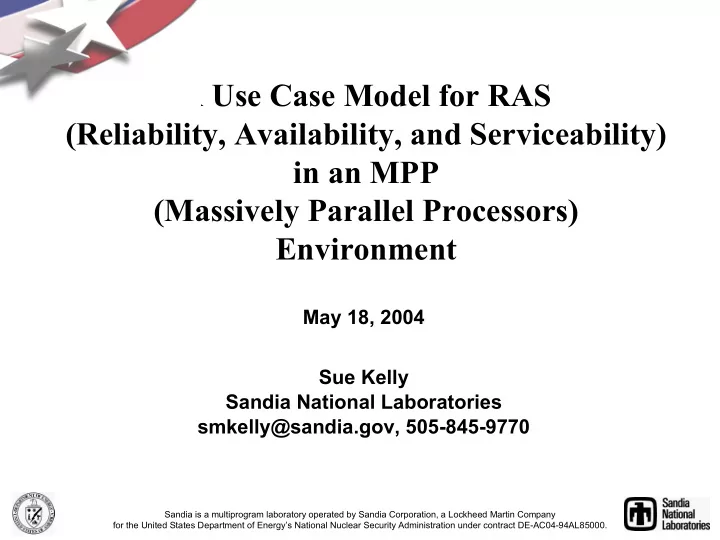

A Use Case Model for RAS (Reliability, Availability, and Serviceability) in an MPP (Massively Parallel Processors) Environment May 18, 2004 Sue Kelly Sandia National Laboratories smkelly@sandia.gov, 505-845-9770 Sandia is a multiprogram laboratory operated by Sandia Corporation, a Lockheed Martin Company for the United States Department of Energy’s National Nuclear Security Administration under contract DE-AC04-94AL85000.
Outline of Talk • A brief tutorial on Use Cases • RAS Features for MPPs Use Case Model
References Applying Use Cases by Geri Schneider and Jason P. Winters, Addison-Wesley, 1998. Object-Oriented Software Engineering: A Use Case Driven Approach by Ivar Jacobson, et. al., Addison-Wesley, 1992. UML Distilled by Martin Fowler with Kendall Scott, Addison-Wesley, 1997. An investigation into RAS Features for Massively Parallel Processor Systems by Suzanne M. Kelly and Jeffry B. Ogden, SAND2002-3164, 2002.
The Unified Modeling Language • A Standard* object modeling language • Unifies the models of Booch, Rumbaugh (OMT) and Jacobson • Not a method; no notion of process • Can incorporate some or all of the UML notations and diagrams (e.g. use cases) into your software development process of choice. Andrew S. Tanenbaum
Use Case Concepts • Use Case – A specific way of using the system by performing some part of the functionality. • Actor – A representation of what interacts with the system. May be a person, another system, or something else (e.g. cron). • Use cases are represented by ovals. I use a naming convention of verb followed by object. Subject is implied by the initiating actor. • An actor is represented by a stick figure. • An arrow indicates the direction of initiation (not necessarily data flow). Request Cash Withdrawal ATM Customer
Use Case Concepts (cont.) «uses» Log Transaction • Each use case constitutes «uses» a complete course of Request Cash events initiated by an actor Withdrawal and specifies the interactive between the Make Deposit ATM Customer actor and the system Change PIN • Use Case Diagram – a graphical representation of the entire set of actors and use cases. Replenish Supplies • Use Case Model – the use Service Provider case diagram plus the descriptive text for each Download Status use case. Timer
Use Case Documentation • My preferred template for each use case: – Description - one or two lines – Actors - list – Pre & Post conditions – Detailed Flow of Events – Alternate Flows – User Interface – Data Requirements
The Value of Use Cases • A customer-friendly way of describing functional and performance requirements • A good basis for developing test cases • An excellent basis for developing the user guide • Can be applied even if not using object-oriented development (OOAD) • A great place to rough-out the GUI • A great place to start finding your data requirements
What Use Cases Do Not DO • They only define the customer visible portion of the system. • They provide minimal information for system architecture design.
Use Case Model of a RAS system for MPPs
Definition of RAS • Reliability - fault avoidance – the likelihood a system or component will sustain full functional operation over its lifetime. – Measured in MTBF (mean time between failures). • Availability - fault tolerance – the likelihood a system is operational at any given time. – Measured in up time percentage. • Serviceability - fault identification and repair – measure of a system’s ability to sustain repairs to faulty components. – Measured in MTTR (mean time to repair) and $$$s.
Features of the Model • Integrates hardware and software RAS • Comprehensive model - I.e. includes RAS features found on the most humble PC all the way to unique MPP-unique RAS features • Generally applicable to clusters and embarrassingly parallel systems
The Actors • Asynchronous Event • Manager Operator User • Operator • Synchronous Event • System Hardware System Software Administrator Manager Administrator • System Software Administrator System Software Programmer System Hardware Administrator • System Software Programmer • User Synchronous Event Asynchronous Event
Use Case Diagram for User Determine status of system resources Determine status of job(s) that Utililize application were or are running checkpoint/restart capability Review the logs of job(s) that Utilize application were run monitoring capabilit y User
Use Case Diagram for System Software Administrator Determine the status of system software components Manage user jobs Restart failed hardware/software Determine the components status of jobs Determine the status of system hardware components Startup/shutdown/ reboot system Run tests/diagnost components ics Data mine current and historical SSA Manage disk space information Review logs
Use Case Diagram for System Software Programmer Upgrade system software Obtain verbose Analyze post-mortem debugging informati a system software on failure System Software Programmer
Use Case Diagrams for System Hardware Administrator and Manager Test hardware component(s) Diagnose questiona Add/remove/replace ble hardware hardware components System Hardware Administrator Retrieve performan ce statistics Manager
Use Case Diagrams for Operator and Synchronous Event Check if system is operational Receive audible/ visible notification Follow notificatio of problems n procedure Operator Perform proactive Backup selected system diagnostics files Synchronous Event
Use Case Diagram for Asynchronous Event Faults hardware Causes environment that can be isolate al failure d Faults hardware that is a single point of failure Causes recoverable error Faults hardware with hot spare Hangs/panic operat Results in unknown ing system event Causes failure Notify SSA of of system software problems service System Asynchronous Event
Example Use Case Description
Conclusions • Use cases are an effective communication tool. • This model is the basis for the Red Storm system.
Recommend
More recommend